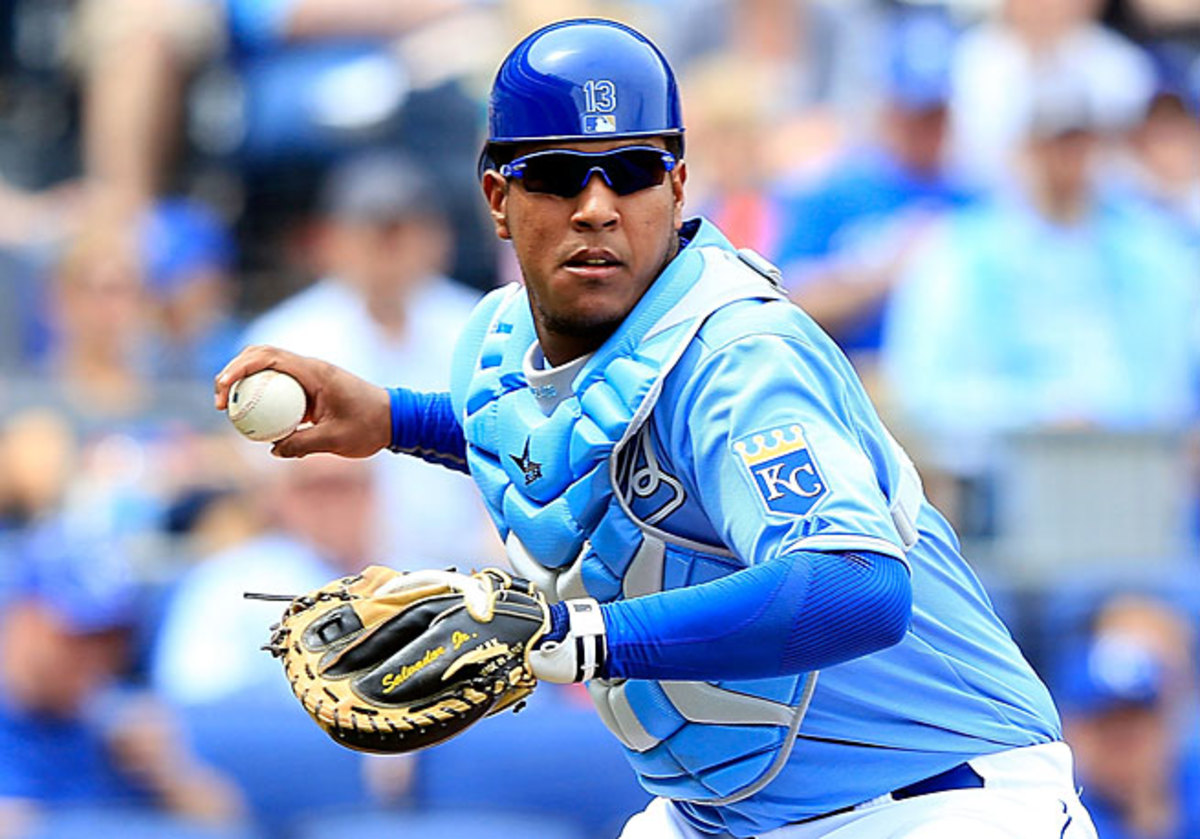Salvador Perez looking like building block Royals have long sought


An exercise: You are starting a baseball team. A team built to win now, and for the next five years. Which under-25-year-old major league player do you build around?
Mike Trout and Bryce Harper are at the top any of these kinds of lists, of course. If you want to build around a young ace, there's Stephen Strasburg. After that? Perhaps Giancarlo Stanton and Jason Heyward, or one of the young shortstops, Starlin Castro and Elvis Andrus. Further down the list, maybe you like Manny Machado, or perhaps you've become a Matt Harvey or Jose Fernandez believer.
But what about a 22-year-old stud who plays elite defense at a premium position, a rising star who's beginning to show that he could bloom into a .300, 20-home run hitter, a player who's already one of the best all-around catchers in baseball?
What about Salvador Perez?
"There just aren't players like Salvy around anymore," Ned Yost says. The Royals manager was sitting in the dugout at US Cellular Field on a recent afternoon, talking about how the good-hit, good-field catcher is the most sought-after commodity in baseball. "You're seeing fewer and fewer of them. Salvy, he's very big but extremely athletic and quick. He throws as well as anyone in the league, he blocks balls like a son of a gun, he works with the pitchers extremely well, and he hits for power and hits for average. That's incredibly unique."
"Guys that have Salvy's skill set," Brian Poldberg, Perez's Double-A manager, says, "you have to go all the back to the Johnny Benches of the game. Five years from now, the way he can throw people out, and the way he can hit right now, I think he's going to be in the upper echelon catchers. Of all time."
Entering a two-game series with the Braves starting Tuesday night, the Royals were 7-5, tied for first with the Tigers in the AL Central, and had allowed the third fewest runs in the league (41). It's early, of course, but the early returns on general manager Dayton Moore's revamped rotation were mostly positive: Ervin Santana has a 2.45 ERA over his first three starts; Wade Davis, acquired from the Rays in December's blockbuster Wil Myers deal, takes the mound on Tuesday after tossing five shutout innings against the Twins last week in a 3-0 win; new ace James Shields, a victim of two hard-luck losses, has pitched well, too.
But Perez, who was off to a slow start at the plate but now has hit in six straight games, has also been part of the story: the new Kansas City pitchers can't stop raving about how it's been working with the young Venezuelan. "Just phenomenal," says Shields. "He's in on every pitch. His arm is tremendous -- some guys you feel you need to rush a little to the plate, not with him. The way he blocks balls, you have confidence to throw your pitches. What I love about him is that he listens and he learns. Everything sticks. I had some great catchers to work with in Tampa over the years, and I'd put him up there already as one of the best, and given how old he is, that's amazing."
"On this team," says pitcher Bruce Chen, "everyone keeps talking about Hos, Mous, Gordo, and Billy [Eric Hosmer, Mike Moustakas, Alex Gordon and Billy Butler], and somehow Salvy's left behind. But if you watch any of our games, you have to realize how important he is. By the end of this season, everyone will know."
It's still more of an art than a science, measuring a catcher's value -- it remains difficult to quantify aspects of the job like calling a good game -- but we should all be able to agree that the game's greatest defensive catcher, and one of the greatest defensive catchers ever, is Perez's Missouri counterpart, the Cardinals' Yadier Molina, who over his career has thrown out an otherworldly 45 percent of base-runners, a figure that's even more impressive when you consider the rising success rates of base-stealers. Last year, with the support behind Molina for MVP, his all-around, dazzling skills were finally getting the proper due.
"Molina, he's the best," says an AL executive. "People talked about the Dave Duncan effect in St. Louis, and that was real, but so is the Yadi effect -- I don't think they win two championships without him, the way he handles that staff. He's a championship type player."
Perez is eight years younger than Molina, a player he idolized growing up in Valencia, Venezuela, but already he's the AL's best catch-and-throw catcher. He's a 6-foot-3, 245-pound Baby Yadi: In just half a season last year -- he returned from a knee injury in late June -- he still led the majors in pickoffs, and he gunned down 42 percent of base runners. "Pop to pop," says Poldberg, referring to the time it takes for a catcher to receive a pitch and fire the ball to the second baseman, "if Salvy's at 1.9 seconds, something's wrong. Usually, he's in the 1.8s. That's Pudge Rodriguez territory."
Last year, just 104 games into his Royals career, Perez set the franchise pickoff record by a catcher (eight) when he lasered a ball to third to pick off the White Sox' Alexei Ramirez. "What makes it work is that he's fearless, and he trusts himself -- he knows exactly how good he is, and he knows that he can throw guys out at every base, at any time," says third baseman Mike Moustakas, who used to flash signs to Perez but now "we just give each other a look and know when a pickoff is coming." He adds, "It's obvious the word is getting out. You see guys not getting off too far anymore."
Most surprising has been Perez's bat: He has a .308 average with a .795 OPS over 127 career games. "When he was coming up they said his swing was long, and that part of his game was going to have to take some time, and we were going to have to take our lumps," says Chen. "But then he comes up and he hits the two farthest home runs I've ever seen at Tiger Stadium and Kauffman Stadium. Think about where he's going to be in two, three years?"
It's still hard to project what kind of hitter Perez will turn into, of course, but if he can be a .300 hitter who hits 20 home runs and continues to play defense at an elite level and stays healthy . . . well, you're talking about a superstar.
With his long face and massive torso and thick lower body, he looks as rock-solid as an Easter Island Moai. "You look at him and you think, awkward and slow," says Chen. "But he's the complete opposite. This kid is ridiculously athletic."
One recent morning Perez was telling the story of how he became a catcher. He was a third baseman growing up -- "I love Miguel Cabrera," he says -- but when he was 12 years old he showed up at a tryout and "there were lines for each position, and no one was in the line for catcher," he says. "So I said, I'll try it, but the ball hit me too hard and I said, No way. This is terrible. I hate it. I'm going back to third base."
A few years later, when he was 15, a family friend advised him that a move to catcher would increase his chances of being noticed by a major league team. He gave it a try, and a year later, the Royals signed him for $55,000. "It's crazy -- one year before I signed, I had no idea how to catch," he says.
Now he's baseball's next great catcher, the next Yadi Molina, and one of the keys to the great resurrection in Kansas City. Take into consideration his ridiculously team friendly contract -- last winter, in the most brilliant move of his rocky tenure, Moore inked Perez to a five-year, $7 million deal with club options through 2019 -- and Perez is one of the most valuable young players in all of baseball. Two years ago, he was Baseball America's 18th ranked Royals prospect; two years ago everyone was talking about Hosmer, Moustakas, Wil Myers, John Lamb and all the other studs from the Best Farm System Ever. Perez? Complete afterthought.
And now? He's exactly the kind of player you build a team around.
